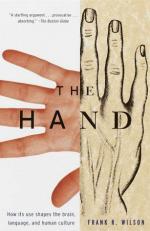|
This section contains 310 words (approx. 1 page at 400 words per page) |

|
Puppet Lessons from Alexandria and Dusseldorf Summary and Analysis
Marionettes exhibit similarities to the human muscle and tendon configuration in arms and legs. Etymologically, "neuron" is a Greek word for cord or fiber and marionettes are puppets moved by strings. The anatomist Herophilus discovers some neurons connect muscles to spinal cord whereas others connect muscles to bone, despite their similar appearance. Another anatomist Galen discovers pairs of muscles, agonist and antagonist, are required to pull against each other for action. Rene Descartes thinks fluid causes action in the eye, but not until Galvani in 1800 are electrical forces found to be the cause that initiates movement.
French physician-neurologist Duchenne determines in 1867 how to demonstrate the physiology of movement. He attaches strings to a model, like a marionette, from a paddle above them, to control movement. The paddle axis is designed to...
(read more from the Puppet Lessons from Alexandria and Dusseldorf Summary)
|
This section contains 310 words (approx. 1 page at 400 words per page) |

|




